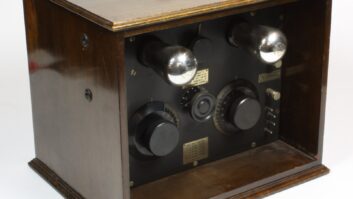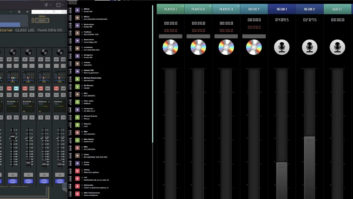
Michael “Catfish” Dosch is director, Virtual Radio Products, for Lawo. This is one in a series of Q&As with industry professionals about their presentations at the upcoming NAB Show in Las Vegas.
Radio World: You’re helming a session entitled “The Coming Virtualization of Radio Studios: Broadcasting + IT = AoIP 2.0,” April 23, 10–10:30 a.m. What is it about?
Michael Dosch: Virtualization is the dematerialization of hardware or embedded products. Your smartphone’s clock app replaces your wristwatch. Scaled up, this idea can include apps running on virtual computers on generic hardware. What makes this possible is the staggering power of the modern CPU.
A small data center may consist of hundreds of generic server devices running thousands of virtual machines. A management layer called a hypervisor hosts and supervises the virtual machines. If a problem occurs in hardware or software, the hypervisor takes action. This is how data centers provide such a high level of service availability.
Radio broadcasters are beginning to explore this technology. The PC is already the center of the radio studio, serving as the source for all of our recorded content. We are already using IP to move audio around the plant. The next step is to virtualize some of the other devices used around the studio and have them running on powerful generic hardware.
The market for radio equipment is limited, and so too is the R&D investment. However, if we adapt the technology from IT for our unique needs in radio, we gain access to billions of dollars of R&D and cutting edge innovation. This is a much more pragmatic approach to radio tech than trying to build everything from scratch. This was the idea behind AoIP and we believe virtualization is the next big thing.
RW: Are the costs lower?
Dosch: Again, consider AoIP. We (I was at Axia at that time) had this notion that we could adapt an Ethernet switch to be used as an audio router. Prior to this idea, audio routers were expensive mainframe devices based on proprietary TDM technology. The adaptation needed to meet certain requirements of reliability, latency, and compatibility, but once these requirements were met, we now were able to build audio routers for a fraction of the cost of the prior method.
The same idea applies to virtualization. Though blade servers are quite powerful, they are also fairly standardized, with multiple vendors offering similar products. The competition along with manufacturing scale ensures that the costs are reasonable. Contrast this with a small radio equipment manufacturer building proprietary hardware. As was the case with the Ethernet switch, the difference in cost is significant.
RW: “Hacking” is the word these days, what are the security concerns for such “virtualized” operations?
Dosch: This is a real concern for everyone in the modern era, but virtualization doesn’t add to the burden. Every radio station relies on audio playout software for most — if not all — recorded audio. So already stations should be quite careful with network security. Adding a few more applications to the same computer infrastructure does not increase the risk, but perhaps it raises awareness further so that engineers are even more careful with their security policies.
RW: We’ve seen this slowly happening over the last couple of decades with DJs sitting in home studios in one city while doing a show for another, but how close are we to a tipping point for everyone and everything not being in the studio?
Dosch: This is absolutely possible now. Whether stations wish to have all of their talent “telecommute” is a programming decision rather than a technical one. I think we will see both styles of operations well into the future. Some programming really benefits from multiple talent interacting in the same location, while some is more suited for remote contribution. The technology gives broadcasters more choices as they imagine how to create content.
RW: A lot of people aren’t going to like this. For instance broadcast hardware makers, what do you tell them?
Dosch: Maybe the best advice for the equipment vendor is this: our radio customers are under tremendous pressure to remain competitive in a changing media environment. In our service to them, we should use every technology at our disposal to help them do more with less. Virtualization offers a path toward lower costs without compromising features and performance.
It is difficult to embrace change, but change is inevitable. If a customer can use a $5,000 Ethernet switch to replace your $50,000 TDM mainframe router, you can fight and win a few battles, but you will ultimately lose the war. It is in the customer’s best interest for you, the broadcast application expert, to adapt this technology trend to his unique requirements.
RW: As studios are decentralized and dissolve into the cloud, what can you say to those who have the romantic notion of the group camaraderie/face-to-face interaction of the old-fashioned studio?
Dosch: I’m a technologist, not a programmer. I leave these debates up to those who know how to create compelling content. But I do know this about technology: It brings options. Most programmers love to have flexibility to pursue creative ideas. Maybe some stations will continue with the traditional studio, maybe some will use a remote model. I suspect we’re going to see new operating styles that we cannot even imagine emerge as a result of what those clever programmers will do once they realize they can do things differently.
RW: Time is tight for NAB Show attendees, so why should they make time out of their busy schedule to take in your session?
Dosch: Because ever-shrinking equipment budgets in ever more demanding programming environments is the new normal. Virtualization can help radio engineers build studio infrastructure that is more flexible and lower in cost. Just as with AoIP, we take an idea from IT, mold it and shape it into exactly what we need for radio, and everyone wins!
For more NAB Show-related news and features check out our NAB Show News page.











